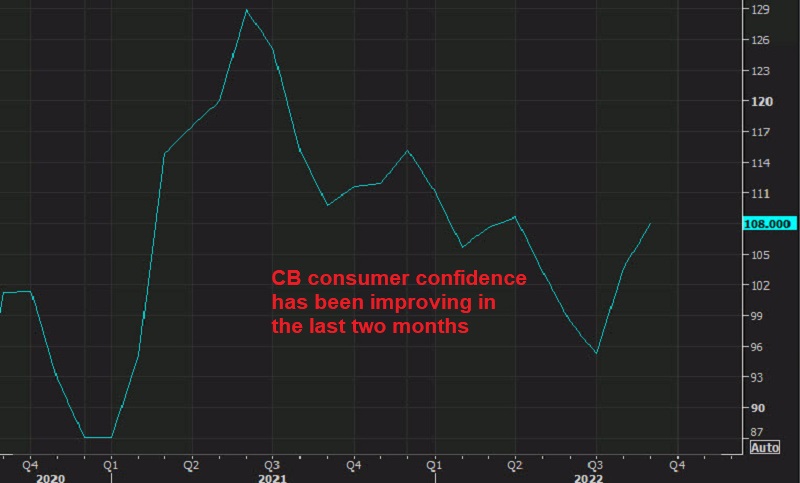US Economic Data Shows Improvement, Keeping the FED Hawkish and USD Bullish
The US economic data is showing improvement, which is strengthening the case for the FED to keep hiking, which will help the USD

The FED was thinking about slowing down or even stopping rate hikes several months ago, as the US and global economy headed into a recession. The US economy fell into a recession indeed, as today’s Q2 GDP revision confirmed after a second consecutive quarter of contraction. But, the GDP number is history, since it shows the economic situation two months ago, while the recent data is showing improvement in the US economy.
This is strengthening the hand of the FED which is expected to continue with strong rate hikes in the coming meeting and today’s comments from FOMC members confirmed that. So, we will continue to buy the USD, particularly;y against risk assets such as commodity dollars, and commodities themselves. Below are some of today’s reports from the US which were quite strong.
US September Conference Board Consumer Confidence
- September consumer confidence 108.0 points vs 104.5 expected
- August consumer sentiment was 103.2 points
- Present situation 149.6 points vs 145.3 prior
- Expectations 80.3 points vs 75.8 prior
- Jobs hard-to-get 11.4% vs 11.6% prior
- 1-year inflation expectations 6.8% vs 7.0% prior
That’s a strong reading and it comes with several strong readings today. The market reaction has been to sell bonds and buy the US dollar. It points to more rate hikes from the Fed.
US August Home Sales Report
- August new home sales 685K vs 500K expected
- Prior was 511K (revised to 532K)
This is a big contrast to some of the latest commentary from home builders. Some argue that because cancellations aren’t factored into this number, it overstates true, completed sales.
The Richmond FED Manufacturing Report for September 2022
- Composite index 0 points vs. -8 in August. The 0.0 level was also the level in July before dipping in August back into negative territory
- Services index 0 points vs. -12 in August
- Manufacturing shipments 14 points vs. -8 in August
- Employment 0 points vs. 11 in August
- Wages 40 points vs. 27 last month
- Availability of skills needed -6 points vs. -3 last month
- Prices paid 10.34 points vs. 12.47 last month
- Prices received 7.66 points vs. 9.31 last month
- New orders -11 points vs -20 last month
- Backlog of orders -25 points vs. -24 last month
- Capacity utilization -4 points vs. -5 last month
- Lender lead times -11 points vs. -14 last month
- Local business conditions -5 points vs. -14 last month
- Capital expenditures 22 points vs. 18 last month
- Finished goods inventories -8 points vs. -5 last month
- Raw materials inventories for vs. -3 points last month
- Equipment and software spending 17 points vs. 14 last month
- Services expenditures 6 points vs. 9 last month
- Shipments 18 points vs. 15 last month
- New orders 13 points vs. 4 last month
- Backlog of orders -13 points vs. -4 last month
- Capacity utilization 14 points vs. 14 last month
- Number of employees 19 points vs. 28 last month
- Wages 61 points vs. 65 last month
- Availability of skills needed -2 points vs. 3 last month
- Prices paid 5.14 points vs. 4.90 last month
- Prices received 4.5 points vs. 4.35 last month
From the Richmond FED:
Two of its three component indexes improved notably: the indexes for shipments and volume of new orders rose from -8 and -20 in August to 14 and -11 in September, respectively. However, the third component, the employment index, fell to 0 from 11 in September, as hiring challenges persisted.
The wage index also increased dramatically, surpassing its July and August levels. The local business conditions index rose but remained negative in September, moving from -14 to -5. Firms’ expectations of conditions over the next six months, too, saw a small increase but remained negative.
There was not much indication of supply chain relief since August, as the indexes for vendor lead time and the backlog of orders remained steady, although both have improved dramatically since earlier this year. On a positive note, the average growth rate of prices paid and prices received both decreased markedly in September, as expectations for both over the next 12 months changed little from August.
- Check out our free forex signals
- Follow the top economic events on FX Leaders economic calendar
- Trade better, discover more Forex Trading Strategies
- Open a FREE Trading Account


